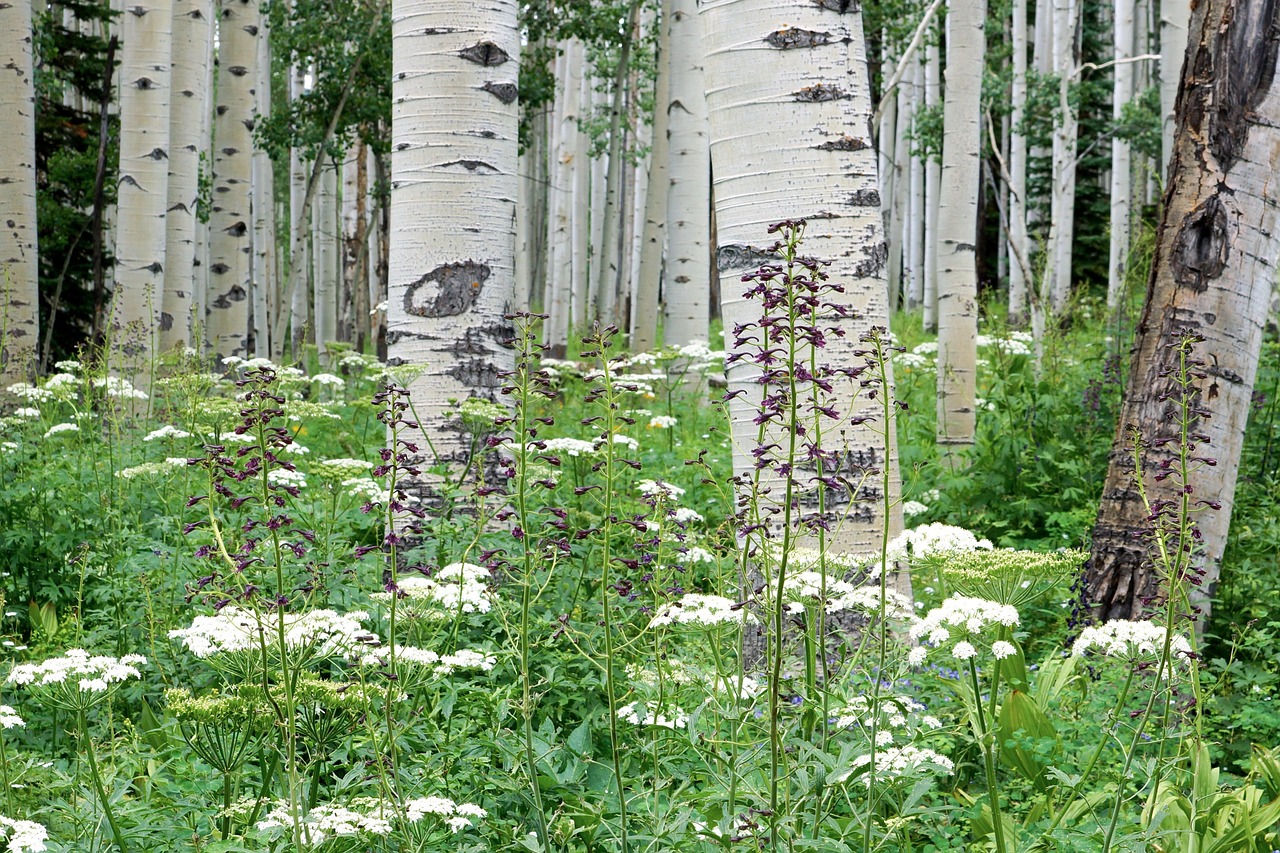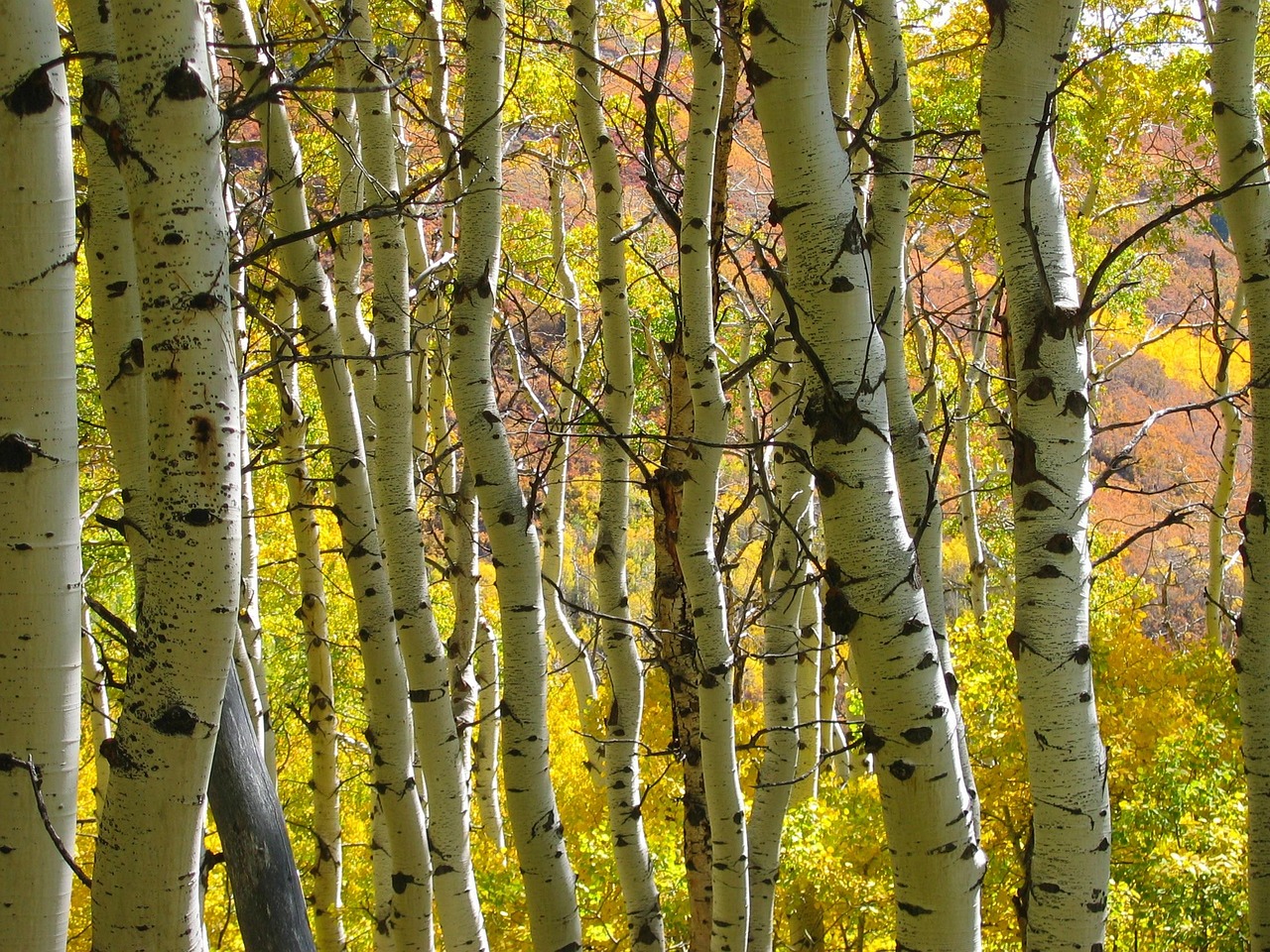Quaking aspens are named for their unique ability to tremble in the wind. The flattened petioles, or leaf stems, allow the leaves to flutter, creating a quaking effect that is visually striking and gives the tree its name.
Understanding Quaking Aspens

Quaking aspens, scientifically known as Populus tremuloides, are a popular tree species found throughout North America. They are especially prevalent in mountainous regions and are cherished for their beauty and ecological significance. The tree typically grows in clusters, forming expansive groves. These groves are renowned for their striking white bark and vibrant fall foliage, which turns a brilliant yellow.
The name “quaking” comes from the distinctive shape of the aspen’s leaf stems. Unlike many other trees, the leaf stems of quaking aspens are flattened, allowing the leaves to move freely with even the slightest breeze. This movement creates a shimmering effect, making them an enchanting sight in natural landscapes.
Quaking aspens are not only notable for their striking appearance but also for their ecological roles. They provide habitat and food for various wildlife species. Birds, deer, and insects depend on these trees for sustenance and shelter. The trees are also important for soil health, as they help prevent erosion with their robust root systems.
Characteristics of Quaking Aspens
Quaking aspens possess several key characteristics that set them apart from other trees. Understanding these traits helps explain why they are beloved by many. Below are some important features:
- Height: Quaking aspens can grow between 20 to 80 feet tall.
- Bark: The bark is smooth and white to light gray, often with black knots.
- Leaves: The leaves are rounded with serrated edges, typically 2 to 4 inches long.
- Root System: They have a shallow root system that allows for sprouting new trees from the roots.
- Reproduction: Quaking aspens can reproduce both sexually through seeds and asexually through root suckers.
The ability to reproduce via root suckers is particularly significant. It allows a single tree to form a large grove of genetically identical trees. This clonal reproduction contributes to the longevity and resilience of aspen populations in various environments.
Distribution and Habitat
Quaking aspens thrive in a variety of habitats across North America. They are commonly found in mountainous regions, mixed forests, and even disturbed areas like clearings and roadways. Their adaptability allows them to grow in various soil types but they prefer well-drained soils with sufficient moisture.
Due to their extensive root systems, quaking aspens play an essential role in stabilizing soil and preventing erosion in their native habitats. They often grow alongside other tree species, contributing to biodiversity in forest ecosystems.
Geographic Range
The geographic range of quaking aspens is quite expansive. They can be found from Canada down into the United States, particularly in states like Colorado, Utah, and Wyoming. Their presence is often associated with higher elevations and cooler climates, making them an integral part of the landscape in many national parks and forests.
| Aspect | Details |
|---|---|
| Scientific Name | Populus tremuloides |
| Height | 20 to 80 feet |
| Leaf Shape | Rounded with serrated edges |
| Bark Color | White to light gray |
This adaptability and ecological importance make quaking aspens an essential species within their ecosystems. The striking appearance of their trembling leaves adds to their charm and appeal, making them a favorite among nature lovers and environmentalists alike.
Ecological Significance of Quaking Aspens
Quaking aspens play a crucial role in their ecosystems. They provide essential habitats and resources for a variety of wildlife. Their presence enhances biodiversity and contributes to the overall health of forest environments. Understanding their ecological significance helps to appreciate why they are vital to both animal and plant life.
Wildlife Habitat
Quaking aspens offer numerous benefits to wildlife. The groves created by these trees serve as a sanctuary for various animals. Here are some ways in which they contribute to wildlife habitats:
- Bird Species: Many birds, including woodpeckers and songbirds, nest in the branches of aspen trees. The trees provide food sources and shelter, making them an attractive habitat.
- Mammals: Deer and elk often feed on the tender leaves and young shoots. Additionally, small mammals such as squirrels and rabbits find refuge among the roots and branches.
- Insects: Quaking aspens host numerous insects, which in turn attract birds and other predators. The trees support a diverse insect community that is crucial for pollination.
Soil Health and Erosion Control
The extensive root systems of quaking aspens play an important role in maintaining soil health. Their roots help bind the soil together, preventing erosion, especially in hilly or mountainous areas. Here are some key benefits related to soil health:
- Soil Stabilization: The roots hold soil in place, reducing the risk of landslides and sediment runoff.
- Nutrient Cycling: Quaking aspens contribute organic matter to the soil through leaf litter. This decomposition enriches the soil, improving its fertility.
- Water Retention: Their root systems enhance water infiltration and retention in the soil, promoting healthier ecosystems.
Quaking Aspens and Climate Adaptation
Quaking aspens exhibit remarkable resilience to various climate conditions. Their ability to thrive in different environments makes them an essential species for adapting to climate change. Understanding how they adapt provides insight into their survival strategies.
Temperature Tolerance
Quaking aspens are well-suited for cooler climates but can also tolerate warmer temperatures. They can survive in areas with fluctuating seasonal temperatures. Some specific adaptations include:
- Cold Hardiness: These trees can withstand cold winters and are often one of the first species to leaf out in spring.
- Drought Resistance: While they prefer moist conditions, quaking aspens can adapt to periods of drought by slowing their growth.
Forest Dynamics and Biodiversity
Quaking aspens contribute to the dynamics of forest ecosystems. They often grow in mixed forests alongside coniferous trees. This diversity enhances the resilience of the forest as a whole. Here are some ways they influence forest dynamics:
- Successional Stages: Quaking aspens are pioneer species that colonize disturbed areas, paving the way for other plant species to establish.
- Biodiversity Hotspots: Their groves create microhabitats that support a variety of plant and animal species, increasing biodiversity.
Cultural Importance of Quaking Aspens
Beyond their ecological roles, quaking aspens hold cultural significance for many communities. Indigenous peoples have traditionally valued these trees for various reasons, from practical uses to spiritual connections.

Traditional Uses
Throughout history, quaking aspens have been utilized by indigenous cultures for various purposes:
- Medicinal Uses: The bark and leaves have been used in traditional medicine for treating ailments.
- Crafting Material: The wood is lightweight and easy to work with, making it suitable for crafting tools and utensils.
Spiritual Connections
Many Native American tribes view quaking aspens as sacred trees. They symbolize resilience and adaptability. The rustling leaves are often thought to carry messages from the spirit world, adding a layer of cultural depth to these trees.
The significance of quaking aspens stretches beyond their physical attributes. They encapsulate a blend of ecological importance and cultural heritage, making them a vital part of both nature and human history.
Threats to Quaking Aspens

Despite their resilience and ecological importance, quaking aspens face several threats that jeopardize their survival. Understanding these threats is crucial for conservation efforts aimed at preserving these magnificent trees. The primary challenges include climate change, invasive species, and human activities.
Climate Change
Climate change poses a significant threat to quaking aspens and their habitats. Rising temperatures and altered precipitation patterns can impact their growth and survival. Specific effects of climate change on quaking aspens include:
- Increased Drought: Extended periods of drought can stress these trees, affecting their ability to thrive. Quaking aspens may struggle to access the necessary water resources for growth.
- Altered Growth Cycles: Changes in seasonal temperatures can disrupt the timing of leaf emergence and nutrient cycling, which are vital for the health of the trees.
- Pest Outbreaks: Warmer temperatures can lead to increased pest populations, such as bark beetles, which can cause significant damage to aspen groves.
Invasive Species
Invasive species can severely impact the health of quaking aspen populations. These non-native species often compete for resources, disrupting the natural balance in ecosystems. Notable invasive threats include:
- Non-Native Plants: Invasive plants can outcompete young aspens for sunlight, water, and nutrients, hindering their growth.
- Pests: Invasive insects, such as the emerald ash borer, pose a risk as they can spread diseases that affect not only aspens but also surrounding tree species.
Human Activities
Human activities have profoundly affected quaking aspen habitats. Urban development, logging, and land conversion for agriculture can lead to habitat loss and fragmentation. Key impacts include:
- Deforestation: Logging practices can remove large areas of aspen groves, directly decreasing their populations.
- Urbanization: Expanding cities often encroach on natural habitats, reducing the space available for these trees to grow.
- Wildfire Management: Fire suppression strategies may inadvertently harm aspen ecosystems. Quaking aspens rely on fire for regeneration in some environments, and suppressing natural fires can lead to a decline in their populations.
Conservation Efforts for Quaking Aspens
Recognizing the threats faced by quaking aspens, various conservation efforts are underway to protect and preserve these vital trees. These initiatives involve collaboration among environmental organizations, government agencies, and local communities.
Restoration Projects
Restoration projects aim to rehabilitate aspen habitats that have been degraded or lost. These projects often focus on:
- Replanting Efforts: Planting young quaking aspens in areas where they have been removed can help restore populations.
- Habitat Protection: Protecting existing aspen groves from development and logging is crucial for maintaining healthy ecosystems.
Research and Monitoring
Ongoing research is vital for understanding the health and dynamics of quaking aspen populations. Monitoring programs help track changes over time and assess the effectiveness of conservation strategies. Key research areas include:
- Pest Management: Studying pest dynamics helps develop strategies to mitigate their impact on aspen trees.
- Disease Surveillance: Monitoring for signs of disease allows for early intervention and treatment of affected trees.
Community Engagement
Engaging local communities in conservation efforts is essential for the success of quaking aspen preservation. Educational programs raise awareness about the importance of these trees and encourage people to participate in conservation activities. Community actions may include:
- Volunteer Planting Events: Organizing community events to plant young aspens fosters a sense of ownership and connection to local ecosystems.
- Awareness Campaigns: Educational outreach helps inform the public about the ecological significance of quaking aspens and the threats they face.
The combination of research, restoration, and community involvement creates a comprehensive approach to safeguarding quaking aspens for future generations. Through these efforts, there is hope for sustaining this iconic tree species and preserving its ecological roles.
Future Prospects for Quaking Aspens

The future of quaking aspens depends on our collective efforts to address the challenges they face. As climate patterns shift and human impacts continue to escalate, it is essential to foster resilience in aspen populations. This can be achieved through adaptive management strategies that consider changing environmental conditions and promote biodiversity.
Adaptive Management Strategies
Adaptive management involves monitoring ecosystems and adjusting practices based on observed changes. For quaking aspens, this could mean:
- Improved Forest Management: Implementing selective logging and controlled burns to maintain healthy aspen groves and prevent overcrowding by invasive species.
- Monitoring Climate Impacts: Regular assessments of climate conditions can inform decisions on where to plant new aspen populations to ensure their survival under changing climates.
- Restoration of Natural Fire Regimes: Recognizing the role of fire in aspen regeneration can help create conditions favorable for new growth and maintain ecosystem health.
Genetic Diversity and Resilience
Maintaining genetic diversity within aspen populations is crucial for their long-term resilience. Efforts should focus on:
- Seed Collection: Gathering seeds from various locations can help ensure diverse genetic material is available for replanting.
- Clonal Diversity: Encouraging the growth of genetically different clones can provide a buffer against disease and pests.
Public Awareness and Education
Enhancing public awareness about the importance of quaking aspens is vital. Educational programs can encourage people to appreciate these trees and participate in conservation efforts. Possible initiatives include:
- Workshops: Hosting workshops that teach community members about the ecological roles of quaking aspens and how to recognize signs of stress or disease.
- Nature Walks: Organizing guided walks in aspen groves can foster a deeper connection with local ecosystems and promote stewardship.
Conclusion
Quaking aspens are more than just beautiful trees; they are vital components of forest ecosystems that provide numerous benefits to wildlife, soil health, and human communities. Their unique ability to tremble in the wind gives them a distinctive charm, while their ecological significance cannot be overstated. As we face increasing threats from climate change, invasive species, and human activities, it becomes imperative to take action to protect these iconic trees.
The ongoing efforts in research, habitat restoration, and community engagement play a crucial role in ensuring the survival of quaking aspens. By understanding their importance, addressing the challenges they face, and promoting conservation, we can work together to safeguard these magnificent trees for future generations. The future of quaking aspens is intertwined with our commitment to preserving the natural world, highlighting the need for sustainable practices that honor our connection with nature.
In conclusion, as we continue to learn about quaking aspens and their vital contributions to our ecosystems, let us strive to protect them, ensuring that their “quaking” leaves will continue to dance in the wind for years to come.
